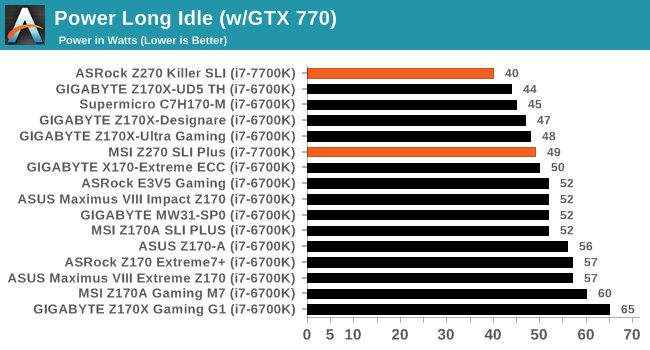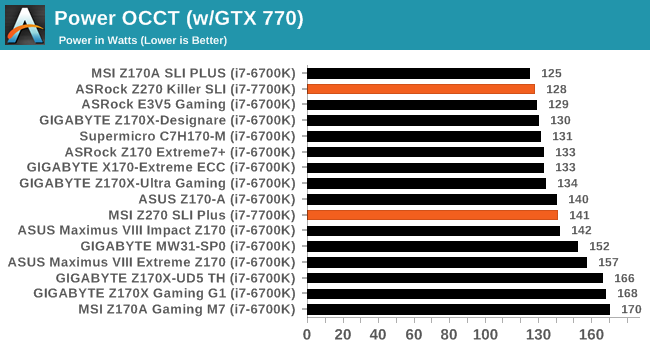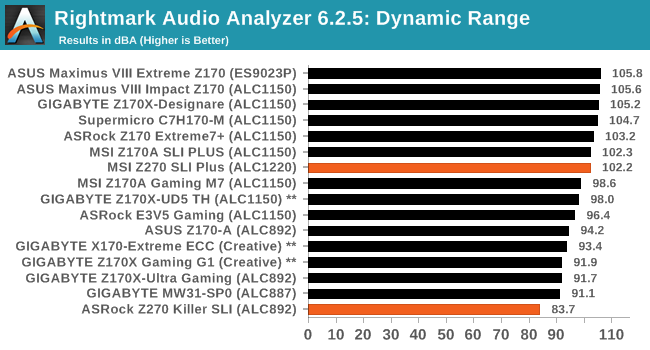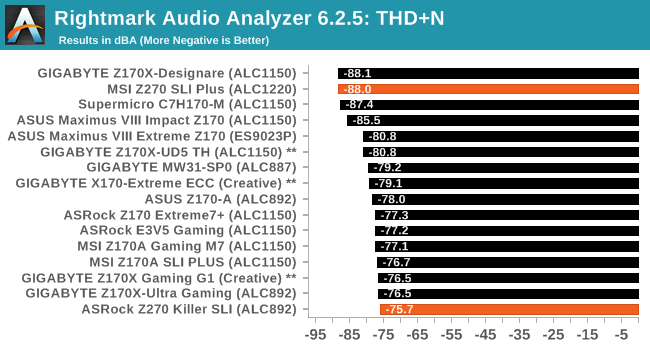Kaby Lake Motherboards at $140: MSI Z270 SLI Plus vs. ASRock Z270 Killer SLI
by E. Fylladitakis on May 1, 2017 10:30 AM EST- Posted in
- Motherboards
- Intel
- MSI
- ASRock
- SLI
- Kaby Lake
- Z270
- Z270 SLI PLUS
- Z270 Killer SLI
System Performance
Not all motherboards are created equal. On the face of it, they should all perform the same and differ only in the functionality they provide - however this is not the case. The obvious pointers are power consumption, but also the ability for the manufacturer to optimize USB speed, audio quality (based on audio codec), POST time and latency. This can come down to manufacturing process and prowess, so these are tested.
Power Consumption
Power consumption was tested on the system while in a single MSI GTX 770 Lightning GPU configuration with a wall meter connected to the Corsair AX1200i power supply. This power supply is Platinum rated, and as I am on a 230-240 V supply, leads to ~75% efficiency > 50W, and 90%+ efficiency at 250W, suitable for both idle and multi-GPU loading. This method of power reading allows us to compare the power management of the UEFI and the board to supply components with power under load, and includes typical PSU losses due to efficiency. These are the real world values that consumers may expect from a typical system (minus the monitor) using this motherboard.



The consumption of the MSI Z270 SLI Plus is a bit on the high side considering the presence of the Intel i7-7700K CPU. The power consumption is comparable to that of Z170 boards with the i7-6700K CPU but we expected better figures than these. The ASRock Z270 Killer SLI fares significantly better, with the relative difference in terms of energy consumption when the system is idling being nearly 20%.
Non UEFI POST Time
Different motherboards have different POST sequences before an operating system is initialized. A lot of this is dependent on the board itself, and POST boot time is determined by the controllers on board (and the sequence of how those extras are organized). As part of our testing, we look at the POST Boot Time using a stopwatch. This is the time from pressing the ON button on the computer to when Windows 7 starts loading. (We discount Windows loading as it is highly variable given Windows specific features.)

The default boot time of both motherboards is exceptional, with the ASRock Z270 Killer SLI landing a time under 10 seconds, making it the motherboard with the fastest boot time that we have tested to this date. The MSI Z270 SLI Plus falls nearly two seconds behind but the boot time of 11.7 seconds still remains excellent. The disabling of all onboard controller and enabling the “fast boot” options does very little to help the boot times of both motherboards.
Rightmark Audio Analyzer 6.2.5
Rightmark:AA indicates how well the sound system is built and isolated from electrical interference (either internally or externally). For this test we connect the Line Out to the Line In using a short six inch 3.5mm to 3.5mm high-quality jack, turn the OS speaker volume to 100%, and run the Rightmark default test suite at 192 kHz, 24-bit. The OS is tuned to 192 kHz/24-bit input and output, and the Line-In volume is adjusted until we have the best RMAA value in the mini-pretest. We look specifically at the Dynamic Range of the audio codec used on board, as well as the Total Harmonic Distortion + Noise.


The two motherboard that we are testing today are worlds apart in terms of audio performance. MSI’s new Realtek ALC1220 codec delivers excellent performance figures, with the dynamic range reaching above 102 dB(A) and THD + Noise hitting -88 dB(A). On the other hand, the performance of the ALC892 codec on the ASRock Z270 Killer SLI is poor, even when compared to older boards that feature the same chipset. Even though it is lacking an optical SPDIF out port, the MSI Z270 SLI Plus is much superior than the ASRock Z270 Killer SLI in terms of audio performance.
USB Backup
For this benchmark, we transfer a set size of files from the SSD to the USB drive using DiskBench, which monitors the time taken to transfer. The files transferred are a 1.52 GB set of 2867 files across 320 folders – 95% of these files are small typical website files, and the rest (90% of the size) are small 30 second HD videos. In an update to pre-Z87 testing, we also run MaxCPU to load up one of the threads during the test which improves general performance up to 15% by causing all the internal pathways to run at full speed.
Due to the introduction of USB 3.1, as of June 2015 we are adjusting our test to use a dual mSATA USB 3.1 Type-C device which should be capable of saturating both USB 3.0 and USB 3.1 connections. We still use the same data set as before, but now use the new device. Results are shown as seconds taken to complete the data transfer.

Naturally, the USB 3.1 controller present on the MSI Z270 SLI Plus gives it a great performance edge, reducing copy times down to 3.1 seconds. Using the USB 3.0 ports on the same board nearly doubles that time, with DiskBench reporting 5.8 seconds. The ASRock Z270 Killer SLI does not have any USB 3.1 ports and its USB 3.0 performance is identical to that of the MSI’s offering.
DPC Latency
Deferred Procedure Call latency is a way in which Windows handles interrupt servicing. In order to wait for a processor to acknowledge the request, the system will queue all interrupt requests by priority. Critical interrupts will be handled as soon as possible, whereas lesser priority requests such as audio will be further down the line. If the audio device requires data, it will have to wait until the request is processed before the buffer is filled.
If the device drivers of higher priority components in a system are poorly implemented, this can cause delays in request scheduling and process time. This can lead to an empty audio buffer and characteristic audible pauses, pops and clicks. The DPC latency checker measures how much time is taken processing DPCs from driver invocation. The lower the value will result in better audio transfer at smaller buffer sizes. Results are measured in microseconds.

The DPC latency figures of both the MSI Z270 SLI Plus and the ASRock Z270 Killer SLI are excellent. The ASRock Z270 Killer SLI is slightly better, scoring a maximum latency of 105 μs. The MSI Z270 SLI Plus reported a maximum latency of 115 μs. Both of these figures are good for modern systems.










20 Comments
View All Comments
A5 - Monday, May 1, 2017 - link
Nice article, more mainstream reviews are always appreciated.austinsguitar - Monday, May 1, 2017 - link
people need to realize that z270 and intel are still a great buy for regular users. its not a bad investment. i just prey that 6core comes in time to consumers.ddriver - Monday, May 1, 2017 - link
Aside from the fact it is highly unlikely it will accept more than a single generation of processors.Cygni - Monday, May 1, 2017 - link
Seems pretty likely that Coffee Lake is intended to be compatible with Z270.ddriver - Monday, May 1, 2017 - link
That would be a new one for intel ;) If that happens, I guess "competition". For years now, intel has been artificially limiting chipset compatibility to squeeze extra chipset sales by obstructing upgrades.ronnie.d.davidson@outlook.com - Sunday, May 7, 2017 - link
Thats not what I've been reading....New Intel Coffee Lake 6 Core CPU's will need the 300 Series Chipset which means....New Motherboard !ronnie.d.davidson@outlook.com - Sunday, May 7, 2017 - link
The Inter Coffee Lake 6 Core CPU's will need the 300 Series Chipsets which means...New Motherboard !fanofanand - Monday, May 1, 2017 - link
Totally agree, more reviews of the volume pieces would benefit far more readers. I won't be buying either of these but at least now I know why.Arbie - Monday, May 1, 2017 - link
It's incredible that they can market something so complex, with so many precision parts, materials, and process steps - not to mention all the ICs - for a delivered price of $140! These are the benefits to us of mass production and sadly low foreign wages. Given that I'd use such a mobo heavily for hours every day, for years, I'd willingly pay more if I knew the workers got more.rocky12345 - Monday, May 1, 2017 - link
Nice write up Thank You. I just looked the MSI board up at Memory Express in Canada it goes for $209.99 CAD which sounds about right after exchange rate.